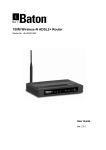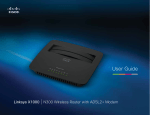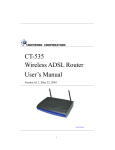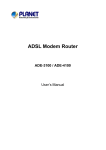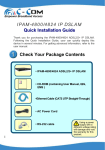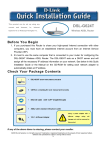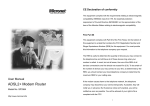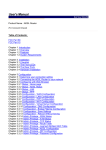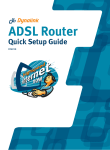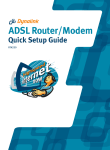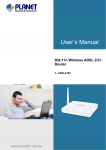Download NT3BB-1P Quick Installation Guide
Transcript
NT3BB-1P User Manual NT3BB-1P Quick Installation Guide i NT3BB-1P Error! Use the Home tab to apply 标题 to the text that you want to appear here. 1 Introduction The NT3BB-1P device is an ADSL access device that supports multiple line modes. It provides one 10/100Base-T Ethernet interface at the user end. The device provides high-speed ADSL broadband connection to the Internet or Intranet for high-end users such as net cafes and office users. The device provides high performance access to the Internet, downlink up to 24 Mbps and uplink up to 1 Mbps. Note: The figures in this document are for reference only. Rear Panel The following table describes the interfaces of the device: Items Description Power switch. Power on or power off the device. POWER Power interface, for connecting to the power adapter. LAN RJ-45 interface, for connecting to the Ethernet interface of PC or other Ethernet devices through Ethernet cable. DSL RJ-11 interface, for connecting to the ADSL interface or a splitter through the telephone cable. RESET (on the side panel) Reset to the factory defaults. Keep the device powered on, then insert a paper clip in to the hole, press and hold for over 3 seconds. The configuration is reset to the factory defaults. NT3BB-1P Error! Use the Home tab to apply 标题 to the text that you want to appear here. 2 Connecting the Router Step 1 Connect the DSL interface of the device and the Modem interface of the splitter through a telephone cable. Connect the phone to the Phone interface of the splitter through a cable. Connect the incoming line to the Line interface of the splitter. The splitter has three interfaces: Line: Connect to a wall phone jack (RJ-11 jack). Modem: Connect to the ADSL jack of the device. Phone: Connect to a telephone set. Step 2 Connect the LAN interface of the device to the network card of the PC through an Ethernet cable (MDI/MDIX). Note: Use twisted-pair cables to connect with the hub or switch. Step 3 Plug one end of the power adapter to the wall outlet and connect the other end to the POWER interface of the device. Figure 1 shows the application diagram for the connection of the router, PC, splitter and the telephone sets, when no telephone set is placed before the splitter. NT3BB-1P Error! Use the Home tab to apply 标题 to the text that you want to appear here. Figure 1 Connection diagram (Without connecting telephone sets before the splitter) The following table describes the interfaces of the device: Items Description Power switch. Power on or power off the device. POWER Power interface, for connecting to the power adapter. LAN RJ-45 interface, for connecting to the Ethernet interface of PC or other Ethernet devices through Ethernet cable. DSL RJ-11 interface, for connecting to the ADSL interface or a splitter through the telephone cable. RESET (on the side panel) Reset to the factory defaults. Keep the device powered on, then insert a paper clip in to the hole, press and hold for over 3 seconds. The configuration is reset to the factory defaults. NT3BB-1P Error! Use the Home tab to apply 标题 to the text that you want to appear here. 3 Web Configuration This chapter describes how to configure the router by using the Web-based configuration utility. 3.1 Access the Router The following is the detailed description of accessing the router for the first time. Step 1 Open the Internet Explorer (IE) browser and enter http://192.168.1.1. Step 2 In the Login page that is displayed, enter the username and password. The username and password of the super user are admin and 3bb. If you log in, the page shown in the following figure appears. You can check, configure and modify all the settings. Note: In the Web configuration page, the settings can be saved permanently. NT3BB-1P Error! Use the Home tab to apply 标题 to the text that you want to appear here. 3.2 Quick Start The Quick Start page will guide you to configure the ADSL router to connect to your ISP (Internet Service Provider). The following sections describe these various configuration parameters. Whether you configure these parameters or use the default ones, click NEXT to enable your Internet connection. When subscribing to a broadband service, you should be aware of the method by which you are connected to the Internet. Your physical WAN device can be connected to the internet by either PPP, ADSL or both. The technical information about the properties of your Internet connection is provided by your Internet service provider (ISP). For example, your ISP should inform you whether you are connected to the Internet using a static or dynamic IP address, and the protocol that you use to communicate on the Internet. In the navigation bar, click Quick Start. The page as shown in the following figure appears. Click RUN WIZARD, there will pop up a new page as shown in the following figure appears. NT3BB-1P Error! Use the Home tab to apply 标题 to the text that you want to appear here. Click EXIT, this page will be closed. Click NEXT, the page as shown in the following figure appears. NT3BB-1P Error! Use the Home tab to apply 标题 to the text that you want to appear here. In this page, you can modify the admin account’s password, and you can make it blank if you do not want to change it. After finishing all quick start settings, it will be saved and effective immediately. Click NEXT, the page as shown in the following figure appears. In this page, you can select a local time zone. Click NEXT, the page as shown in the following figure appears. NT3BB-1P Error! Use the Home tab to apply 标题 to the text that you want to appear here. There are four WAN connection types: Dynamic IP Address, Static IP Address, PPPoE/PPPoA and Bridge Mode. Select the appropriate WAN connection type which is provided by your ISP. Take an example, select the PPPoE/PPPoA, and then click NEXT, the page as shown in the following figure appears. NT3BB-1P Error! Use the Home tab to apply 标题 to the text that you want to appear here. The following table describes the parameters in this page: Field Description PPP Username Enter the username for PPPoE dial-up, which is provided by your ISP. PPP Password Enter the password for PPPoE dial-up, which is provided by your ISP. VPI Virtual path identifier (VPI) is the virtual path between two points in an ATM network. Its valid value is in the range of 0 to 255. Enter the correct VPI provided by your ISP. By default, VPI is set to 0. VCI Virtual channel identifier (VCI) is the virtual channel between two points in an ATM network. Its valid value is in the range of 1 to 65535. Enter the correct VCI provided by your ISP. By default, VCI is set to 33. Connection Type You can select PPPoE LLC, PPPoE VC-Mux, NT3BB-1P Error! Use the Home tab to apply 标题 to the text that you want to appear here. Field Description PPPoA LLC or PPPoA VC-Mux. In this example, the encapsulation mode is set to PPPoE LLC. After setting, click NEXT, the page as shown in the following figure appears. Click BACK to modify the settings. Click NEXT to save the settings. Click EXIT to cancel the settings. Note: After saving the settings in the Quick Start page, you can view this WAN connection settings in the Interface Setup > Internet page. NT3BB-1P Error! Use the Home tab to apply 标题 to the text that you want to appear here. 3.3 Interface Setup In the navigation bar, click Interface Setup. The Interface Setup page that is displayed contains Internet and LAN. 3.3.1 Internet Choose Interface Setup > Internet. The Internet page that is displayed contains ATM VC, QoS and Encapsulation etc. Click Internet pane, the page shown in the following figure appears. In this page, you can configure WAN interface of your router. NT3BB-1P Error! Use the Home tab to apply 标题 to the text that you want to appear here. NT3BB-1P Error! Use the Home tab to apply 标题 to the text that you want to appear here. The following table describes the parameters of this page: Field Description Virtual Circuit You can select a virtual circuit from the drop-list. Click PVCs Summary to view the eight PVCs (from PVC0 to PVC7). Only PVC0 is activated by default. Status You can select Activated or Deactivated for the selected virtual circuit. VPI The virtual path between two points in an ATM network, ranging from 0 to 255. VCI The virtual channel between two points in an ATM network, ranging from 1 to 65535. ATM QoS The QoS category of the PVC. You can choose UBR, CBR, nrt-VBR or rt-VBR. PCR Peak cell rate (PCR) is the maximum rate at which cells can be transmitted along a connection in the ATM network. Its value ranges from 1 to 65535. SCR Sustain cell rate (SCR) is the maximum rate that traffic can pass over a PVC without the risk of cell loss. Its value ranges from 0 to 65535. MBS Maximum burst size (MBS) is the maximum number of cells that can be transmitted at the PCR. Its value ranges from 0 to 65535. IP Version The IP Protocol you adopted. You can choose IPv4/IPv6, IPv4 or IPv6. Select the connection mode provided by your ISP. ISP There are four options available: Dynamic IP Address, Static IP Address, PPPoA/PPPoE or Bridge Mode. Servicename You can set the service name. Username Enter the username for PPPoE dial-up, which is provided by your ISP. NT3BB-1P Error! Use the Home tab to apply 标题 to the text that you want to appear here. Field Description Password Enter the password for PPPoE dial-up, which is provided by your ISP. Encapsulation You can choose PPPoE LLC, PPPoE VC-Mux, PPPoA LLC or PPPoA VC-Mux. Bridge Interface You can choose Activated or Deactivated. Connection To control the time of connecting to the internet. You can choose Always On (Recommended), Connect On-Demand (Close if idle for xx minutes), or Connect Manually TCP MSS Option You can keep the default value 0 or set a tcp mss value. The range is from 100 to 1452. Default Route Choose the current PVC as the default pvc, and it works in the routing mode. You can enable or disable default route. Get IP Address You can choose Static, or Dynamic. Static IP Address When Static is selected, you can enter the IP address for dial-up, which is provided by your ISP IP Subnet Mask When Static is selected, you can enter the IP subnet mask for dial-up, which is provided by your ISP Gateway When Static is selected, you can enter the gate way IP for dial-up, which is provided by your ISP NAT Select it to enable Network Address Translation (NAT) function. If you do not select it and you want to access the Internet normally, you must add a route on the uplink equipment. Otherwise, the access to the Internet fails. Normally, it is enabled. TCP MTU Option You can keep the default value 0 or set a TCP MTU value. The range is from 100 to 1500. NT3BB-1P Error! Use the Home tab to apply 标题 to the text that you want to appear here. Field Description Dynamic Route You can select RIP1, RIP2-B, RIP2-M Direction You can select None, Both, IN Only, OUT Only Multicast You can choose Disabled Internet Group Management Protocol (IGMP) function, or choose enable IGMP v1, or IGMP v2. Click PVCs Summary beside the field Virtual Circuit, and the following figure appears. You can view the information of each PVC. If you select Dynamic IP Address in the ISP encapsulation, the page shown in the following figure appears. In this page, you can configure parameters of this PVC. NT3BB-1P Error! Use the Home tab to apply 标题 to the text that you want to appear here. The following table describes the parameters of this page: Field Description Encapsulation You can choose 1483 Bridged IP LLC, 1483 Bridged IP VC-Mux, 1483 Routed IP LLC(IPoA), 1483 Routed IP VC-Mux. Bridge Interface You can choose Activated or Deactivated. Default Route You can enable or disable default route. TCP MTU Option You can keep the default value 0 or set a tcp mtu value. The range is from 100 to 1500. NAT Select it to enable Network Address Translation (NAT) function. If you do not select it and you want to access the Internet normally, you must add a route on the uplink equipment. Otherwise, the access to the Internet fails. Normally, it is enabled. Dynamic Route You can select RIP1, RIP2-B, RIP2-M. Direction You can select None, Both, IN Only, OUT Only Multicast You can choose Disabled Internet Group Management Protocol (IGMP) function, or NT3BB-1P Error! Use the Home tab to apply 标题 to the text that you want to appear here. Field Description choose enable IGMP v1, or IGMP v2. If you select Static IP Address in the ISP encapsulation, the page shown in the following figure appears. In this page, you can configure parameters of this PVC. The following table describes the parameters of this page: Field Description Encapsulation You can choose 1483 Bridged IP LLC, 1483 Bridged IP VC-Mux, 1483 Routed IP LLC(IPoA), 1483 Routed IP VC-Mux. Default Route You can enable or disable the default route. TCP MTU Option You can keep the default value 0 or set a tcp mtu value. The range is from 100 to 1500. Static IP Address You can enter the ip address for dial-up, which is provided by your ISP IP Subnet Mask You can enter the IP subnet mask for dial-up, NT3BB-1P Error! Use the Home tab to apply 标题 to the text that you want to appear here. Field Description which is provided by your ISP. Gateway You can enter the gate way ip for dial-up, which is provided by your ISP. NAT Select it to enable Network Address Translation (NAT) function. If you do not select it and you want to access the Internet normally, you must add a route on the uplink equipment. Otherwise, the access to the Internet fails. Normally, it is enabled. Dynamic Route You can select RIP1, RIP2-B, RIP2-M. Direction You can select None, Both, IN Only, OUT Only. Multicast You can choose Disabled Internet Group Management Protocol (IGMP) function, or choose enable IGMP v1 or IGMP v2. If Bridge Mode is selected in the ISP encapsulation, the page shown in the following figure appears. In this page, you can configure parameters of this PVC. The following table describes the parameters of this page: Field Description ISP You can choose Bridge mode from these options. Encapsulation You can choose 1483 Bridged IP LLC or 1483 Bridged IP VC-Mux. NT3BB-1P Error! Use the Home tab to apply 标题 to the text that you want to appear here. After finishing, click SAVE to apply the settings of this PVC. 3.3.2 LAN Choose Interface Setup > LAN. The LAN page that is displayed contains Router Local IP and DHCP. In this page, you can change IP address of the router. The default IP address is 192.168.1.1, which is the private IP address of the router. The following table describes the parameters of this page: Field IP Address Description Enter the IP address of LAN interface. It is recommended to use an address from a block that is reserved for private use. This address block is 192.168.1.1- 192.168.255.254. NT3BB-1P Error! Use the Home tab to apply 标题 to the text that you want to appear here. Field Description IP Subnet Mask Enter the subnet mask of LAN interface. The range of subnet mask is from 255.255.0.0-255.255.255.254. Dynamic Route You can select RIP1, RIP2-B, RIP2-M Direction You can select None, Both, IN Only, OUT Only Multicast You can choose Disabled Internet Group Management Protocol (IGMP) function, or choose enable IGMP v1 or IGMP v2. IGMP Snooping Select enable or disable IGMP Snooping. DHCP You can choose Disabled, Enabled or Relay. If set to Enabled, the router can assign IP addresses, IP default gateway and DNS Servers to the host in Windows95, Windows NT and other operation systems that support the DHCP client. Starting IP Address It specifies the first IP address. IP Pool Count The router assigns IP address range based on the IP pool counted to the host. Lease Time The lease time determines the period that the host retains the assigned IP addresses before the IP addresses change. The default is 259200 seconds. Physical Ports If remove the tag’√’, LAN PC can’t apply for an IP from CPE through the protocol ‘DHCP’. DHCP Table Hostname It displays the host name of the DHCP client. IP Address It displays the IP address assigned to the DHCP client from the router. MAC Address It displays the MAC address of the DHCP client. Each Ethernet device has a unique MAC address. The MAC address is assigned at the factory consisting of six pairs of hexadecimal characters, for example, 00-A0-C5-00-02-12. Status The status of your IP address. Expire Time It displays the lease time. The lease time determines the period that the host retains the NT3BB-1P Error! Use the Home tab to apply 标题 to the text that you want to appear here. Field Description assigned IP addresses before the IP addresses change. You can choose Use Auto Discovered DNS Server Only or Use User Discovered DNS Server Only. If you select Auto Discovered, the router accepts the firstly-received DNS assignment from one of the PPPoA, PPPoE or MER enabled PVC(s) during the connection establishment. If select User Discovered, enter the IP addresses of the primary and secondary DNS servers. DNS Relay Primary Server DNS Enter the IP address of the primary DNS server. Secondary Server DNS Enter the IP address of the secondary DNS Server. Dynamic Host Configuration Protocol (DHCP) allows the individual PC to obtain the TCP/IP configuration from the centralized DHCP server. You can configure this router as a DHCP server or disable it. The DHCP server can assign IP address, IP default gateway, and DNS server to DHCP clients. This router can also act as a surrogate DHCP server (DHCP proxy) where it relays IP address assignment from an actual DHCP server to clients. You can enable or disable DHCP server or DHCP proxy. In the DHCP field, choose Disabled, the page shown in the following figure appears. NT3BB-1P Error! Use the Home tab to apply 标题 to the text that you want to appear here. In the DHCP field, choose Relay, the page shown in the following figure appears.























